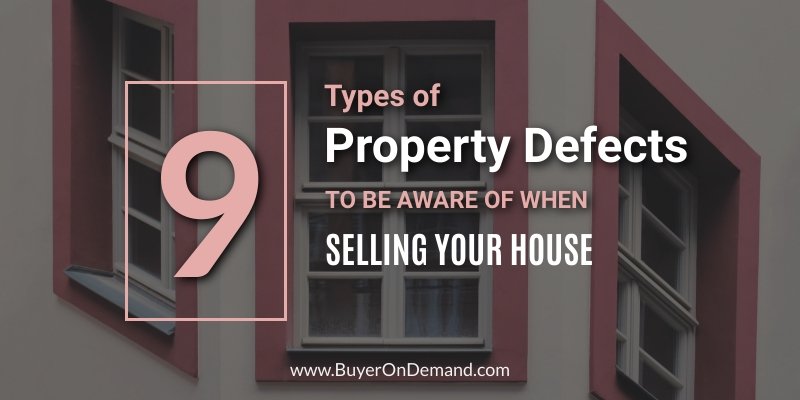If you’re contemplating selling a home, you likely find yourself with an array of different types of questions. Among these questions are likely to be what you particularly need to be on the lookout when selling a home.
In this regard, there are nine more commonplace types of residential property defects that you need to be aware of when selling a home.
These are potential property defects that can impact the overall value of a residence.

1. Damp External Walls
A commonplace type of residential defect is damp external walls. Walls can become damp for an array of different reasons. In addition, damp walls can be fairly easily overlooked if the issue is contained primarily to a wall’s interior. Damps walls oftentimes serve as a signal that other issues, including serious ones, may exist at a particularly property. These associated issues can include some type of water leakage at the premises that have damaged the walls and may be resulting in other issues as well.
2. Failed Downspouts and Gutters
Another commonplace residential defect that fairly regularly exists at a home is failed downspouts and gutters. The most common failure points of downspouts and gutters are corners of guttering, joins, and rainwater outlets. A blocked or corroded gutter can cause a multitude of different problems, including damage to a foundation or walls.
3. Failures
Roof failures represent another category of residential property defects that exist with some regularity. These include damaged or aged tiles. The end result of undue wear and tear on roof tiles are water entering into the attic of other parts of a residence. In addition, broken or damaged tiles can have a similar final effect.
4. Alterations to Structure
Yet another type of residential defect is that which arises from alterations made to a property. For example, if a load bearing wall is altered at the premises, it can result in defects throughout the property. This type of defect many require the utilization of steel reinforcement to remediate the problem. If course, a load bearing wall should not be altered in the first instance as a matter of routine. However, that does not mean that such a change is not going to have occurred at a particular residence.
5. General Condensation Issues Throughout a Residence
The lack of proper ventilation in a residence can result in the occurrence of more generalized condensation throughout a home. In the alternative, this type of condensation can occur persistently in certain zones within a structure. Condensation that occurs with regularity in a residence can result in defects or damage to the property. This can include everything from damage to walls, flooring, and other surfaces to other elements of the physical structure of the premises.
6. Condensation in Doors and Windows
A common residential defect involves certain types of doors and windows commonly utilized in residential property in this day and age. This type of defect also involves condensation, in this case in doors and windows. Because of the design of these doors and windows oftentimes found in homes condensation develops within the sealed double glazed unit of these features. This occurs as a result of the degradation of the seals originally found on these doors and windows.
7. Defects to a Flat Roof
Some residents feature a flat roof. This is more commonplace on town-homes and condos as opposed to single family homes. The typical flat roof historically was constructed with mineral felt or asphalt covering. The lifespan of this type of material is generally thought to be 10 to 20 years before defects begin to occur. Other flat roof coverings like glass reinforced plastic are being utilized. These types of covering have longer lifespans of upwards to 40 years. Defects in flat roofs commonly are caused by UV rays, damaged flashings, and ponding. Ponding involves the pooling of water on a flat roof because of inefficient of improper draining.
8. Structural Movement
A fairly common type of defect on residential property is caused by structural movement. Structural movement can cause an array of significant defects in a home, including:
- cracking
- bowing
- leaning walls
- sticking doors
- sticking windows
The most common types of structural movement include:
- subsidence
- heave
- settlement
- thermal movement
- seasonal movement
9. Eroded Pointing
Yet another kind of defect that is relatively commonplace on residential property is eroded pointing. Eroded pointing generally can be found on brickwork of a residence that is exposed to the elements. The exposure to the elements results in weathering over time. It can also result from guttering at a residence that has failed, resulting in water running over exposed brick. Pointing issues can also occur to older masonry walls that were lime-based. In more recent times, a harder cement is utilized that lessens the risk of eroded pointing, or the extent of it if it does occur.
These more commonplace types of residential property defects are what a homeowner or prospective buyer need to be aware of when involved in the residential real estate market. These are defects that can result in an impact on the price of a residence.
A home inspector will be able to identify these different types of residential property defects. Moreover, a professional can provide insights into the extent to which one or another of these defects impacts the overall market value of a particular residence.
Need To Sell Your Charleston House Fast?
Do you have a house you need to sell fast that is in need of repair? We buy houses in any condition! We pay cash and you will not pay any commissions, agents, or fees. Put your address and email below and answer 5 easy questions on the next page to get a cash offer in 24 hours!
